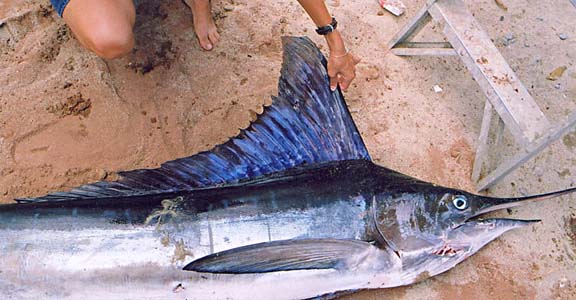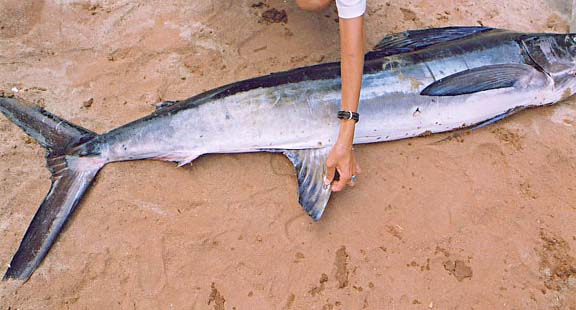
Jorge Bergin's East Cape Mystery Marlin
![]()
|
Baja's mysterious marlin with clipped dorsal and anal fins photographed at East Cape, Baja California Sur, Mexico. Photo courtesy George "Jorge" Bergin. |
WHAT KIND OF MARLIN IS THIS, STRIPED, WHITE, OR SOMETHING ELSE?
By Gene Kira, January 2003, as published in Western Outdoor News:
If there's one fish species you'd think would be quite thoroughly researched and understood by now, it would be Baja California's bread-and-butter offshore quarry, the striped marlin, Tetrapturus audax.
After all, the Mexican state of Baja California Sur has the world's best supply of these fish, and also the world's largest fleet of sport fishing boats chasing them.
Furthermore, the state capital of La Paz has Mexico's largest community of marine biologists, and on a somewhat darker note, just offshore on the Pacific Ocean is the world's largest fleet of quasi-legal commercial longline boats bootlegging marlin for Japan under the guise of doing "shark research."
|
|
Whether by legal (or illegal) commercial harvest, by ethical catch-and-release sport fishing, or for scientific research, it's pretty safe to say that in Mexico's fish-surrounded territory of Baja California Sur, more human eyeballs have seen more striped marlin, for more years, than at any other place in the world.
Baja knows marlin.
So, it came as a real surprise recently to receive some very unusual marlin photographs from East Cape resident George "Jorge" Bergin, and after sending those pictures to a number of authorities, to realize that what Bergin found was something new and strange, even to this world class bunch of marlin experts.
What Bergin has documented are a fair number--say, several dozen per year--of very small, very slender marlin weighing a maximum of about 80 pounds that are caught annually from East Cape to Cabo San Lucas.
These special fish are mixed together with the thousands of unavoidable regular dink marlin that are caught around the tip of Baja every year, and like them, they are usually released quickly, without even being looked at.
But Bergin's dink marlin are different. Their dorsal fins are chopped off horizontally about six inches from the tip, as neatly as if you'd lopped them off with a cleaver. And their anal fins are similarly truncated, but at about a forty-five degree angle. Additionally, says Bergin, their heads and pectoral fins are different from a striper's, and even the meat is distinct, according to the operators of the well-known East Cape Smoke House fish processing service.
So, what the heck are these things?
Bergin's first reaction was that maybe these fish are stray Atlantic Ocean white marlin, Tetrapturus albidus, that have somehow found their way to Baja California. But, I don't really think so. While it is true that white marlin are smaller than stripers, they have never been recorded in the Pacific Ocean, and besides, their fins are not sharply chopped off like Bergin's fish, but are distinctly rounded at the tips.
Dutch fish expert Peter Langstraat, who fishes a couple of months per year at East Cape, was intrigued and mystified by Bergin's photos, saying, "It should be out of the question to find white marlin anywhere in the Pacific. But on the other hand, if I look at the fins, the shape of the head, I cannot fit it to either striped, blue, or black marlin. Interesting stuff."
An inquiry with several East Coast marlin experts wasn't a whole lot of help. Nobody back there thought the fish was a white marlin. Some thought it was definitely nothing more than a small striper. Others said, "Well...hmmmm..."
Closer to home, La Paz authority Alexander Klett had several records of similar fish, and said that he had also tentatively categorized them as small striped marlin, but I got the feeling that was mostly because there was no better pigeonhole to stick them into.
Personally, I had never seen a striped marlin of any size with fins like Bergin's fish, and I had a hard time with these striper theories, so I decided to abandon academia for the moment and check with people who deal physically with a lot of marlin, eyeball-to-eyeball.
Gary Graham of East Cape's Baja On The Fly probably sees as many or more striped marlin as any other U.S. guide, every year, during his regular stints at East Cape, and especially during his annual trips to the incredible Thetis Bank fall fish pile-up off Magdalena Bay, where it is entirely possible to raise a few hundred stripers per week to the teasers. Graham--also an IGFA representative for Baja California--said he's caught plenty of really small stripers, and as far as he's concerned they basically have normal fin shapes.
"We had a preponderance of smaller fish at Magdalena Bay this year," Graham said, "many more than usual. Particularly on our last trip, these fish were a lot smaller, 50 or 60 pounds."
And referring to a previous East Cape catch, Graham added, "We had one fish that was in the 35 to 40-pound range. There was nothing unique about it. It looked just like a regular small marlin."
Graham said he doesn't think George Bergin's strange fish is any standard species of marlin. "It's not a white marlin. I really believe it's probably a hybrid of some kind," he said.
|
|
Robert Muñoz of Robert's Fish Mounts in Los Angeles has carefully examined thousands of striped marlin of all sizes, and that includes at least a couple of hundred marlin weighing less than 80 pounds. The smallest marlin he's ever made a mount of weighed only eight pounds, and at that extremely small size, Muñoz says, they do look different, "all dorsal fin, and skinny body."
But, he says, although he's seen plenty of obvious abnormalities such as double fins, double bills, and so forth, the normal dorsal and anal fins of small striped marlin are always pointed, just like the full-grown fish. Even with all his years of experience, Muñoz has never seen the truncated fin effect of George Bergin's mystery marlin.
Are these puzzling fish really a wandering tribe of Atlantic white marlin, as Bergin has theorized?
Or, are they merely an unusual morphological variant of juvenile striped marlin, as the academics seem to prefer?
Or, as Gary Graham suggests, are they some kind of billfish hybrid, a cross between different marlin species, or perhaps even with sailfish?
Or, as everybody is wondering--and nobody wants to say--could this actually be a new species of marlin, discovered in Baja California after all these years?
One thing is certain. The unusual, square-finned marlin documented by East Cape's George Bergin are not one-of-a-kind freaks, nor are they even true rarities. Decent numbers of these fish are caught each year, and they run true to form, as part of a seemingly consistent population, caught in different sizes, but all looking similar to one another.
Only the preservation and scientific examination of an actual specimen will answer that question, and George Bergin is on the prowl at East Cape, ready to grab the next fish he finds at the fillet tables, and have it frozen for posterity.
With just a little luck, this year we should have more news on "Jorge" Bergin's East Cape mystery marlin.
(Related East Cape articles and reports may be found at Mexfish.com's main East Cape information page. See weekly fishing news, photos, and reports from the major sportfishing vacation areas of Mexico including the East Cape area in "Mexico Fishing News.")
MEXICO FISHING INFO EAST CAPE FISHING INFO "WEEKLY MEXICO FISHING NEWS" FISH PHOTO GALLERY

